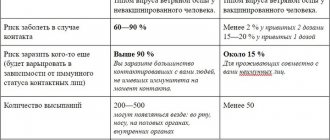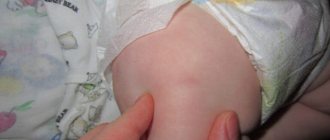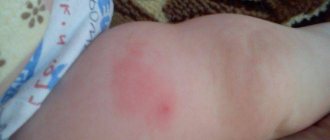Vaccination against tuberculosis is carried out in most countries of the world (approximately 64). It is not always included in the main vaccination calendar; it is mandatory. This applies to people who live in unfavorable living conditions. Vaccinations are also often carried out precisely because of the high surge of the disease. The causative agent of the disease is acid-fast bacteria of the genus Mycobacterium.
Tuberculosis is an infectious disease caused by mycobacterium (Koch bacillus). According to statistics, children account for 7-8% of those infected with Koch's bacillus. Newborns are especially susceptible to tuberculosis. Infection occurs from adult patients. The disease can be transmitted in the following ways: by sneezing, coughing, talking, or using common household objects. It happens that children are vaccinated, but there is no trace of the BCG vaccination. What does it mean? Is this situation dangerous or not?
The danger of tuberculosis disease
The lungs are mainly affected by the disease. The main symptoms are coughing with sputum production. Later other symptoms appear. The patient may cough up blood, the body is completely exhausted.
The disease occurs unnoticed. The father and mother note that the child’s behavior has changed, loss of usual mobility, as well as cheerfulness. In younger children, tearfulness and moodiness are noted. In preschool age, fatigue appears quickly. In adolescents, signs of intoxication are reflected in classes: poor memory, inattention. The children lose their appetite and digestion is disrupted.
In the future, cough becomes the main manifestation of the disease. What other signs of this dangerous disease may exist:
- the child develops excessive sweating, even if he is not hot, and this is especially noticeable in the afternoon;
- as noted above, the child loses appetite and has problems losing weight;
- Shortness of breath may occur with minimal physical activity, such as walking or climbing stairs.
In any case, if you begin to notice any changes in your child, you should immediately consult a doctor.

Contraindications to the introduction of BCG into the child’s body
BCG is a fairly serious vaccination that has a number of contraindications, which the doctor should inform parents about immediately before administering the vaccine. What are these contraindications you will see below:
- if the patient has any intrauterine infections or purulent damage to the body;
- the child is slightly premature and weighs less than 2.5 kilograms;
- the child has mental health problems and various neurological abnormalities;
- for ARVI or other viral diseases;
- if any family members already have tuberculosis.
These were contraindications for the initial administration of vaccination, however, there are cases when the procedure may need to be repeated. And this time there are also a number of contraindications, namely:
- the presence of cancer or damage to cells of the circulatory system;
- the child has an acute respiratory viral infection or a non-infectious disease;
- the presence of allergic reactions that can cause significant harm to health;
- if a child has been given mantu and the result is either positive or not clear to doctors, then it is better to refuse repeated vaccination;
- Before this, the child had an unusual reaction to BCG, then it is better for him not to get this vaccination again;
- if the patient is undergoing radiation therapy.
BCG vaccination rules
The vaccine is given on the fourth to sixth day after birth. In this case, two types of vaccines are used: BCG and BCG-M. The BCG vaccine is often used for children who are born but weigh at least 2.5 kg.

BCG-M is administered to children who have contraindications to the use of BCG. For example, premature babies (up to 2 kg). Also, children have lesions of the central nervous system and a congenital disease of the newborn, caused by isoimmunological incompatibility of the blood of the fetus and mother for erythrocyte antigens.
Infants react differently to tuberculosis vaccination. When the injection site turns red, this reaction is considered normal throughout the year. There is no need to run to the doctor with such a reaction. For such cases, a scheduled inspection is provided. Parents can show the mantoux reaction and no longer worry about it.
Popular Prevention of typhoid fever with the Tifivak vaccine
What especially frightens father and mother is the abscess that forms. So, after vaccination, the injection site begins to fester. This is normal. In fact, over the course of some months, an abscess with a white head in the middle appears at the puncture site. Over time, a regular crust appears in place. It is precisely this crust that should not be peeled off or even smeared with ointments. It will disappear on its own over time.
A small scar will remain. Sometimes father and mother turn to medical professionals about the issue of the absence of a scar. This happens often. The scar does not appear for a year. This also worries parents. It is important to carefully understand the issue here. There are several reasons for this phenomenon:
- Incorrect vaccination. For example, the graft was made too deeply. So, nothing is visible on the surface, there is no trace.
- The second reason can be attributed to the characteristics of the body. The child has not developed immunity specifically to this bacillus.
Parents should carefully monitor their child's health. For any manifestations or changes in the skin, you should consult a doctor. After all, tuberculosis is not something to joke about. And vaccination is one of the necessary measures.
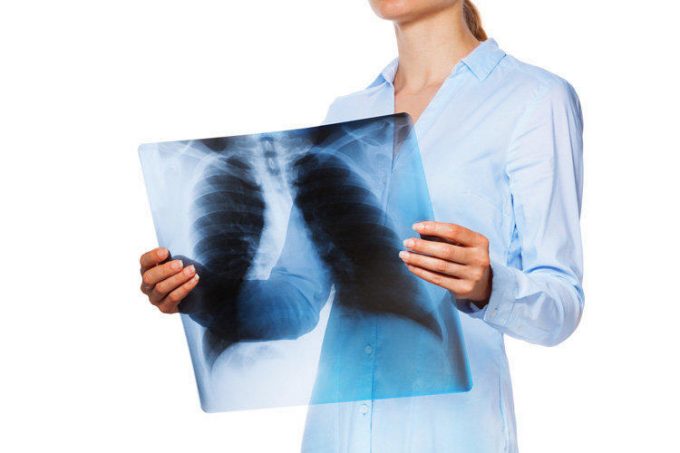
Even if there is no scar, then it is also worth going to the doctor. The doctor will probably prescribe reintroduction of the bacteria.
After vaccination, you need to pay attention to the child’s well-being. The child may not feel well for a couple of days. The main symptoms include temperature. It may be elevated for a couple of days. It can always be sold, but it is better to consult a doctor on this issue. If the temperature has been for more than three days, then this is not a good symptom. Here it is important to consult a doctor in time and take the child to the hospital for examination. If the temperature is above 39 degrees, be sure to call an ambulance.
Size of scars after vaccination against tuberculosis
The scar comes in different sizes, which determine how well the vaccination was carried out:
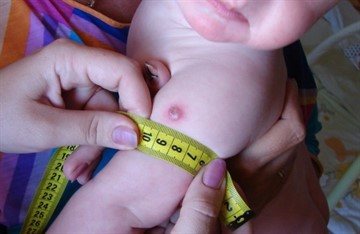
- small size – less than 4 mm;
- medium – up to 8 mm;
- large size – up to 10 mm.
A small scar indicates a minimal degree of protection against the disease. In this case, the vaccination was ineffective. Immunity is valid in this case for only 3 years.
A size of up to 8 mm gives a positive result for up to 7 years, which means that the body is reliably protected. When the scar is too large, more than 10 mm, this indicates a lack of immunity. Perhaps the medical staff made a mistake when administering the vaccine.
To bathe or not
In principle, there are no strict taboos. Just monitor your child's well-being. When the thermometer already shows 39 C, you cannot bathe your child at that temperature.
After vaccinations, babies should not be bathed; they still need to undergo routine examinations with a pediatrician. This way you definitely won’t have to worry about your child’s health.
The reaction to BCG does not occur instantly. Usually after two months an abscess appears at the injection site. Afterwards a crust appears and the area heals.
If there are no complications, then the healing process lasts no more than five months. The area of skin where vaccination was carried out initially turns purple or acquires a purple, blue, or burgundy hue. This is normal.

An abscess appears in the darkened area. A red bubble filled with liquid may appear in the center. Sometimes the abscesses break out and the contents pour out.
Attention! It is strictly forbidden to treat the wound with various antiseptics. It is forbidden to squeeze pus out of the wound.
A scar indicates a successful BCG vaccination and the creation of an immune system response. A scar is created with a length of 2 to 10 millimeters:
- 2–4 millimeters: protection functions for three to four years;
- 5–8 millimeters: vaccine exposure over seven years;
- from 8 millimeters: immunity has developed over seven years.
The correct response looks like this:
- A white papule appears at the injection site. Disappears after ten minutes or half an hour.
- After a month or two, the injection area turns purple, an abscess with a vesicle appears, and a scab forms on top. Sometimes the resulting pus can drain out on its own. To remove it, use a simple napkin.
- After about four months after the injection, the wound heals and a scar forms. This is the body's standard response to BCG.
Characteristics of the positive qualities of the vaccine
Possessing high protective properties, the domestic vaccine produces a minimal number of adverse reactions. Among its important qualities it should be noted:
- specific harmlessness. During vaccine production, strict control is ensured over the level of residual virulence of the strain necessary for the formation of immunity, in order to prevent the virulence index from increasing to a value dangerous for the human body;
- purity (this indicator indicates the absence of impurities of foreign microflora in the composition of the drug);
- stability of the total bacterial content, allowing residual virulence to be maintained at the required level, without increasing or decreasing it;
- specific activity - this parameter indicates the number of viable bacteria in the preparation. Any fluctuations in one direction or another can make the vaccine unsuitable for use: a decrease in the number of such bacteria will reduce the vaccine’s ability to develop immunity against tuberculosis in the human body, and an increase in them will make it dangerous;
- high dispersion index - not lower than 1.5. This characteristic shows the degree of presence of suspended particles in the composition of the grafting suspension - the smaller they are, the more homogeneous the suspension and the higher the dispersion;
- thermal stability - the ability to retain the maximum number of viable microorganisms when storing the vaccine in a thermostat;
- solubility - when adding a solvent, the contents of the ampoule should dissolve in it within 1 minute;
- the presence of a vacuum in sealed ampoules with grafting material.
We recommend reading! Follow the link: Anti-tuberculosis BCG vaccination
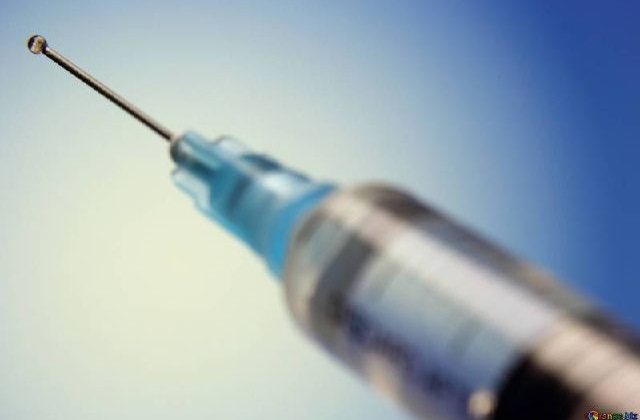
The BCG vaccination is absolutely harmless. In rare cases, side effects are possible after vaccination in the form of redness and swelling of the arm, and fever. But the risk of their occurrence and the severity of the consequences are incomparable with the consequences of infection with a lethal form of tuberculosis.
There is no trace of the BCG vaccination
Vaccinated children may not have a scar. This situation occurs many times: in 5–10% of children, no traces remain from the first vaccination. The main reasons for this include:
- defects in the process of introducing liquid are acceptable;
- vaccine that is expired or stored incorrectly;
- the presence of innate strong anti-tuberculosis immunity.
Popular Reliability of protection against infections with the MMR vaccine
Some advise getting a second BCG vaccination. This is already determined by the doctor.

How does tuberculosis vaccination manifest itself in an infant?
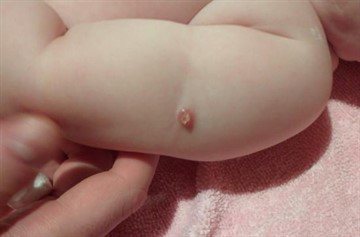
This occurs 1-1.5 months after administration of the drug. Many parents worry when the papule turns bluish, burgundy or purple. Changes of this nature are completely natural. Immunity to tuberculosis will finally be formed 4-4.5 months after the injection.
During this period, the papule can fill with purulent contents, break through, and become covered with a crust. Everything is exactly as it should be.
To avoid complications, timely care of the papule is important. After healing, a BCG scar forms. The vaccine mark is an indicator of how immunity against tuberculosis is developed.
Instructions for parents
No matter what vaccine is administered to a child, BCG or BCG-m, a scar remains after some time of healing.
- If there are no problems during administration, then the vaccine is of excellent quality.
- If the child does not have a scar, then the father and mother are obliged to reduce the baby’s contact with possible tuberculosis patients.
In such patients, the risk of infection increases or the disease may develop into a more complicated form of the course. It is important to get re-vaccinated.
Why is a keloid scar dangerous after BCG?
Wounds usually heal within about a year. The completion of this is the formation of a scar. Keloid belongs to benign formations.
The cause of keloid is a genetic predisposition, namely a high level of the enzyme responsible for the production of collagen, which helps heal wounds and smooth the skin.
Also, keloid scars can appear in athletes, since due to the use of protein mixtures, improper formation of the scar occurs.
It is easy to damage. For example, it can be touched by nails, clothes, or torn off when washing. Healing takes a long time. An infection may occur. If you do not see a doctor in time and start treatment, it will quickly grow throughout the body. Signs of a well-executed BCG vaccine:
- After the injection, a white papule forms.
- A month after the injection, you may notice redness on the skin.
- A scarlet blister or abscess will appear on the grafted area, but subsequently a crust will appear. A scarlet scar of 3-10 millimeters appears.
How to deal with keloid scars and is it possible to get rid of them?
If your child encounters such a problem, then the first thing to do is consult a doctor. He will be able to choose treatment.
It can consist of either a superficial fight against the scar, that is, by applying bandages or other safe methods, or resorting to drug treatment. Here you can use various pharmaceutical ointments, gels, injections, which are also prescribed exclusively by a doctor.
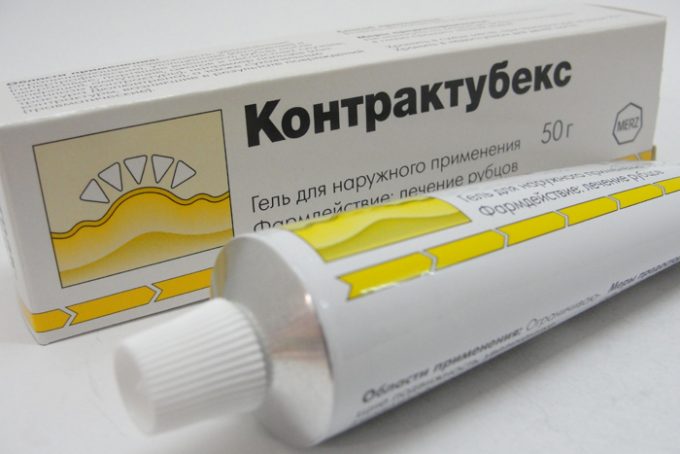
Now that science is developing more and more, it has become possible to remove keloid scars using physiotherapy. These include electrophoresis, ultraphonophoresis and mesotherapy. These procedures should help, but if not, then the only option left is surgery, namely excision of scar tissue.
Are there preventative measures?
Of course, tuberculosis is one of the most difficult diseases, since it does not manifest itself immediately and is almost imperceptible even for the most infected person. But still, if you want to avoid the disease, here are some tips for preventing tuberculosis:
- Be sure to strengthen your immune system. You need to eat as many fresh vegetables and fruits as possible, especially citrus fruits, drink freshly squeezed juices and take courses of vitamin C;
- enjoy physical activity and walks in the fresh air. Both of these points can be combined into one by training on street areas or riding a bicycle or other sports equipment;
- Healthy food. Consume as little “food waste” as possible, such as chips, soda, and flour products. Give preference to complex carbohydrates in the form of cereals, whole grain bread and be sure to maintain water balance (about two liters per day);
- avoid stressful conditions and overwork, which also weaken the immune system and create a favorable environment for the development of the disease;
- be sure to get enough sleep. Go to bed before midnight and spend about 7-8 hours a day in bed, without using gadgets or other distracting objects before bed.
If you follow simple rules, you will significantly reduce the risk of developing tuberculosis and even many other diseases.
Possible deviations and complications in healing
Complications after administration of the BCG vaccine are rare. Typically, patients with innate weak immunity experience negative consequences. In children with immunodeficiency, in 90% of cases local negative reactions are observed: inflammation of the lymph nodes, severe growth of a purulent focus. But in general, side effects occur in only one vaccinated child out of 1000.
A side effect may be osteomyelitis - purulent necrosis of bone tissue. But such a serious complication is a consequence of the poor quality of the injection solution. According to medical statistics, in almost all cases of complications the medical specialist is to blame for either giving the injection incorrectly or using a low-quality drug.
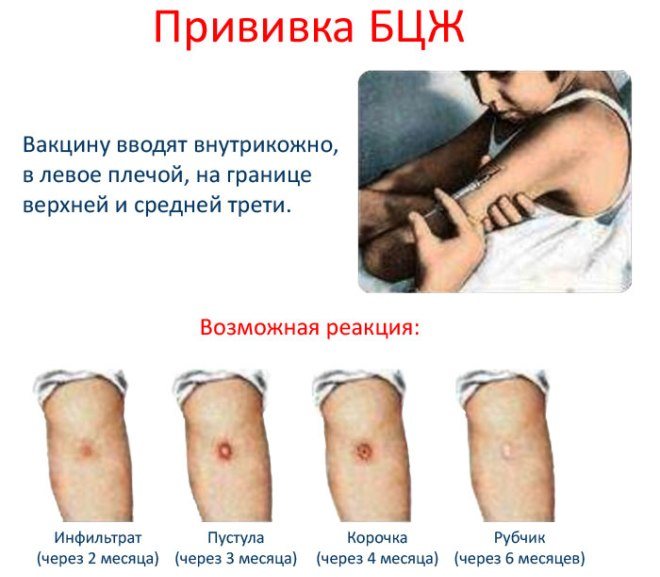
The most common complications include:
- cold abscess - a limited accumulation of pus, resulting from the subcutaneous insertion of a needle, developing a month after the procedure, requiring surgical intervention;
- extensive ulcerative formation exceeding 1 cm in diameter, which occurs when the child’s body is sensitive to the vaccine, is treated with topical medications;
- inflammation of the lymph nodes, which develops when introduced bacteria penetrate through the blood into the lymph nodes (if the node reaches more than 1 cm, it is removed surgically);
- keloid - a reddened and swollen scar resulting from a skin reaction to the vaccine;
- a generalized infectious lesion of the body that develops in the presence of disturbances in the functioning of the immune system;
- Osteitis is a bone tuberculosis that appears about a year after the procedure due to immune disorders.
How do you feel about mandatory vaccination?
- Positively, it prevents many diseases. 60%, 2641 votes
2641 votes 60%2641 votes - 60% of all votes
- Negatively, these are all government schemes to make it easier to manage us. 26%, 1157 votes
1157 votes 26%
1157 votes - 26% of all votes
- Neutral, I don’t think it has any effect on my health. 13%, 592 votes
592 votes 13%
592 votes - 13% of all votes
Total votes: 4390
Votes: 4365
January 17, 2018
×
You or from your IP have already voted.





